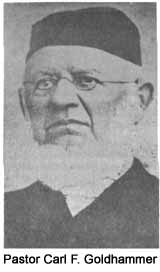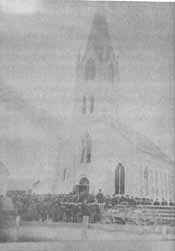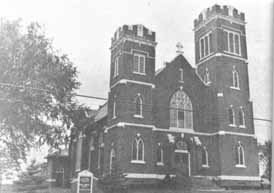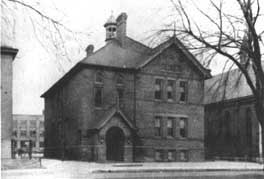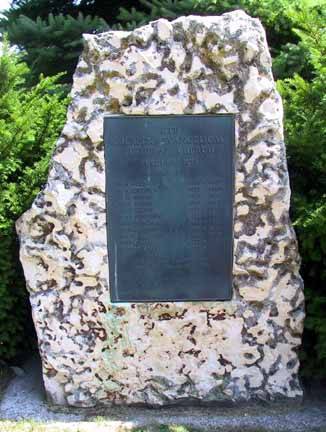LUTHERANS OF MANITOWOC COUNTY

|
The story of Lutherans in Manitowoc County begins with St. John's Evangelical Lutheran Church in Newtonburg. Established in the Spring of 1851, by Rev. Carl F. GOLDAMMER, it is the oldest Lutheran church in the county. It still operates today. During this time period there was a large influx of German Lutherans in the county. Rev. GOLDAMMER was responsible for establishing many missions churches throughout the county, many of which later became established churches. These included the churches in Newtonburg, Manitowoc, Reedsville, and Two Rivers. (NOTE: Rev. Goldammer's surname is spelled Goldhammer. Goldammer is correct, so I have reflected the correct spelling on this page.) 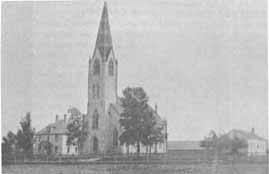
 ST. JOHN'S EVANGELICAL LUTHERAN CHURCH, NEWTONBURG
Information from: "A History of Manitowoc County", Ralph G. Plumb; "History of Manitowoc County", Dr. Louis Falge; St. John's Evangelical Lutheran church was founded in the year 1851 A.D. It was the first Lutheran congregation in Manitowoc County. St. John's was founded one year after the establishment of Newton Township. The church is situated about five miles southwest of the city of Manitowoc.
The first pastor of the congregation was Pastor Carl F. Goldammer. Pastor Goldammer was born in Urspergk Saxony, on Feb. 9, 1821. He received his Theological training in Germany. He was also an immigrant. His first work was in Dodge County, administering to the spiritual needs of the German immigrants. In 1855, Pastor Goldammer left the congregation to accept a call extended by St. John's of Manitowoc. The menfolk put out calls for a new pastor. Pastor STREISSGUTH served the congregation from 1856-1857. He would stop on his travels between Algoma and Milwaukee. Rev. Goldammer did not limited his services. At the same time, he held services in Manitowoc.(See First German Lutheran, Manitowoc). On April 9, 1855, Rev. Goldammer accepted the call to the congregation in Manitowoc. In 1857, Reverend P.H. SPRENGELING accepted their call to serve them. During his serve, the congregation constructed a new frame church. The previous structure had been of logs. Time of worship was wet at 9:00 a.m. on a Sunday morning from Easter to September. At the time many families had no horse or wagon for travel. The trip to church was made on foot. Due to potentially inclement weather during the colder months, time of worship from September to Easter was 10:00 a.m. At this time the members agreed to pay the pastor at least two dollars per year for his salary. In 1863, the members of the congregation agreed to pay the Pastor $1.50 per family per year in cash and supply him with the necessities of life. In September 1901, the Newton church celebrated it's golden anniversary. Among the pastors have been Revs. C. Wagner, E. STRUBE, A, PEIPER and Christian SEIKER. In 1903, a school was established. A quote from the booklet on the One Hundredth Anniversary of the Congregation, "With an iron will and confidence in their God these hardy pioneers cut a livelihood out of the Wisconsin forest and gave us the fertile farms which play such a vital part in maintaining St. John's Congregation in this community today. We can rightfully say that their confidence and faith in God played a part in establishing their new home in Wisconsin's Virgin Forest. Surely these pioneers worked, clearing land, tilling the soil, sewing and reaping, or they starved to death. IN those days there were no government agencies to sustain the farmer and help him over a bad year, he had to make his way the best he could and he knew how to do it. This sturdy pioneer did not only think of his daily bread in terms of work, earning power, dollars and cents, he thought of his daily bread in terms of blessings from God. He understood the truth and unless the Lord bless the labor of his hands, he works without lasting success". End of quote. In 2000, under God's guidance and protection the congregation has grown to a family of over 600 members. The school is currently a Pre K-8th Grade Lutheran Elementary School. There are currently 100 students 4 full time teachers and 3 part time teachers.

This church was established in 1858. It no longer exists today. It was located in the town of Newton in the area of Weyer's Corners. A tract of land 2 acres and 88 rods was donated for church use by Freidrich and Dorothy SACHSE. The structure was a wood frame building about 30 feet wide and 40 feet long. When the church was disbanded in 1947, the bell from the 40 foot bell tower was electrified and was given to Bethany Lutheran Church Manitowoc. The furniture and fixtures were given to a mission church in Fond du lac. The members joined St. John's Ev. Lutheran in Newtonburg. All that remains in the area now is the cemetery (71).

FIRST GERMAN LUTHERAN, MANITOWOC Rev. Goldammer began this church as a mission of St. John's about 1853 in a school house at the corner of Washington and Seventh Street, Manitowoc. Services were held every second Tuesday of the month. As Manitowoc began to grow, it was decided a church should be built. In 1853, a lot on the corner of South 10th and Marshall was purchased. This land became unsuitable. A lot on South Eighth and Marshall was partially donated by Sam HINCKLEY of New York, the remainder purchased by the congregation. By this time, Rev. Goldammer had given up many of his missions and concentrated on establishing the Manitowoc congregation. The church was first organized and named as Evangelical Trinity. It was dedicated in 1856. But in 1860 it was renamed to First German Evangelical Lutheran Church. A new church was built in 1873. The building first used by the German Society was sold and is being used as a home on 20th St. St. Mary's Congregation purchased the church dedicated on 1856. It was used until 1899 when the present St. Mary's building was erected. From "A History of Manitowoc County", Ralph G. Plumb Rev. Goldammer was not a man to limit his usefulness and as early as 1851 he came to Manitowoc every second week to hold services with a few families. For years these gatherings took place in the old district school at the corner of South Seventh and Washington streets. Finally on April 9, 1855 St. John's congregation was organized in the village with thirty families in church connection and it was decided to call Rev. Goldammer to the parish. He accepted and a church, parsonage and school were completed the following year, the latter being enlarged in 1859 to meet the growing demands. The church was a frame structure 35 by 50 feet in dimensions, which was capable of seating about four hundred people. In 1858 Rev. Goldammer left for Burlington, Wis. and Rev. Philip KOEHLER accepted the work and responsibility for the next nine years. In 1861 the congregation had a membership of ninety-one families; in 1865 the report shows 184 families and 193 children in school attendance. By act of the legislature March 23, 1866 the congregation was incorporated and in the same year a new school was erected, which continued to do duty for twenty-five years until it was taken away to make room for the present structure. Rev. KOEHLER left in 1867 and was succeeded b Rev. M.. QUEHL. It was during his pastorate that the old church proving utterly inadequate, it was decided to build a new brick structure. The building was completed in 1873 at a cost of $16,000 and is one of the most commodious in the city. By this time Rev. K. HUEBNER had taken up pastoral work in the city but after two years service he gave way, in 1874, to Rev. G. THIELE, later of Milwaukee. Rev. F. PIEPER assumed charge in 1876, followed by Rev. R. PIEPER in 1878. Two years later the Synod of Minnesota and Wisconsin met at St. Johns and the church was again chosen as the gathering place in 1894. In February 1891 Rev. Karl MACHMUELLER, the present pastor, assumed charge and has assisted materially in the development of church life. The congregation numbers 435 families and there are 250 children in attendance at the school. A thriving ladies' society is maintained in connection with the church.(1904) First German Lutheran Society- Manitowoc by Louis Falge This Society was organized in 1853. In 1855, a neat comfortable
church, 30x50 feet, capable of seating about 400, was erected. The
church has flourished amazingly, and now has a large membership. Rev.
0.F. EBERT is the pastor. Beside the church, the society owns a brick
parsonage 30x30 feet, two stories, with a wing 15x20; a school house
25x40, two stories, and the whole of the block fronting on Eight
street, between Hancock and Marshall streets; a valuable piece of
property. About 200 scholars are in regular attendance at the school.
ANOTHER NEW CHURCH.-A neat and substantial structure is being erected on Eighth Street, South side of the river, ?????? for the German Lutheran Society, and when finished will be a tasty Church edifice, and a credit to the village. The frame was raised last week and it is nearly enclosed, and we hear that it will be finished in about two months. Manitowoc Tribune, Manitowoc, Wis. Thursday, August 9, 1855 P. 5  ST. JOHN EVANGELICAL LUTHERAN CHURCH OF GIBSON Ousted Pastor is Put Out Gibson Parsonage Sheriff Gets Court Order To Evict Gruendemann On Schlueter Advice The Rev. Otto Gruendemann, ousted last November as pastor of the Evangelical Lutheran St. John church of Gibson by vote of the congregation, was Wednesday forcibly ejected from the church parsonage by Sheriff Max Hiller Jr. The ouster proceedings followed a hearing before Judge Detling in circuit court this week, in which the trustees of the congregation were plaintiffs in the suit to recover possession of the parsonage. The court signed an eviction order which was carried out by the sheriff yesterday. The Rev. Gruendemann made no defense. He wrote a letter to Judge Detling in which he explained at length the steps that led up to his dismissal by the congregaton he served for 10 years. The court was compelled to disregard this communication and advise the Gibson pastor to consult an attorney. The pastor, in answering the letter of Judge Detling, advised that it was financially impossible for him to engage counsel. Saw Counsel He said he conferred with counsel of the trustees of the Gibson church and was told that the eviction proceedings were being taken on the advice of the Rev. E.B. Schlueter, district president. William Menges, Raymond Meineke, Fred Schmidt, Carl Stueck, William Rehbein and Clarence Eberling as trustees of the Evangelical Lutheran St. John congretation brought the action against the Rev. Gruendemann. The purpose, according to the statement of counsel for the plaintiffs, was to secure the use of the pastorage for the new minister, the Rev. Walter Klinke, who came to the Gibson charge from Fond du Lac several months ago to succeed the ousted minister. He has been making his home with members of the congregation since taht time. Friend Houses Him After the sheriff's deputies moved the household property of the Gruendemanns from the parsonage it was loaded on a van and taken to the home of a friendly member of the congregation. In his eight-page letter the Rev. Gruendemann said, "I expected that they would give me the charges black on white as I had asked them to do. Now that I am compelled to seek employment elsewhere I felt the need of a written statement by the congregation which ousted me which would vindicate my character at least". The ousted pastor also serves a congregation at Two Rivers, which has taken no preceedings against him, he said. Manitowoc Herald Times, Manitowoc, Wis. July 18, 1935 P. 1

ST. JOHN'S EVANGELICAL LUTHERAN CHURCH, TWO RIVERS Three miles up the East Twin River from Shoto, Emanuel Congregation was established on September 9, 1860. Many of the Two Rivers Lutherans traveled up the river by boat or on foot to meet for church in the small village near the tannery. It has been recorded that in November 1862, Pastor KOEHLER performed 35 baptisms. Thirty-one persons signed the constitution of the newly formed parish. Land was purchased for the church and cemetery. The Lutherans in the village of Two Rivers decided they no longer wanted to travel up the river for services. On Feb. 1, 1861, St. John's was established. The first services were held at Smith's Meeting house, located on Washington Street between 15th and 16th streets. The building was built in 1857 and served as a gathering place for the congregation. On May 14, 1864, St. John's purchased the church building of St. Paul Episcopal Church. St. Paul had been abandoned for several years due to the loss of members during the Civil War. When this church building was purchased, Emanuel Congregation at Tannery was disbanded. Only the cemetery remains.(#88) "A History of Manitowoc County", Ralph G. Plumb As early as 1861 occasional Lutheran services were held in the village of Two Rivers but it was not until 1863 that St.Johns Congregation was organized by Rev. H. BARTHELS, a. missionary pastor of the church. In the same year "the little brown church" built and owned by the Episcopals was purchased from Bishop KEMPER and was used as a place of worship by the new congregation. Rev. BARTHELS remained until the latter part of 1865 and was succeeded by Rev. Braun and under his pastorate a parsonage was built. In October 1869 Rev. Braun was succeeded by Rev. ZUBERBIER, who died in the midst of his activities in 1872, whereupon Rev. C. Jaeger assumed pastoral duties for six years, he now being a resident of Racine. His successor was Rev. P. Lucas, who passed away at Two Rivers July 28 1881, Rev. J. P. KOEHLER then taking up the work. He remained seven years, at the end of which time he resigned to accept a position as professor in the Northwestern Theological Seminary in Watertown. It was under his guidance that the congregation decided to build a new church edifice. The building operations, however, were carried on by his successor, Rev. A. F. SIEGLER, the dedication taking place in 1899. In September 1892, the present pastor, Rev. C. A. F. DOEHLER,, assumed charge of the church and under his leadership it has prospered, numbering now about nine hundred communicants. The school, started at the same time as the church, was for ten years under the care of the pastors but from that time on teachers were hired and the institution now numbers 160 scholars. Two frame structures are utilized for school purpose, one of them being the old church. 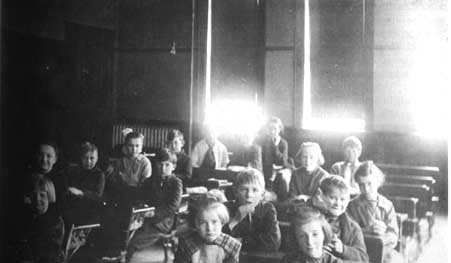 Students at St. John's School, Two Rivers c1917-1921 Students Unidentified The last German confirmation class was confirmed on May 6, 1921 ROSE ANNA MARIE JAECKEL is the girl in the front row center with the big bow (the girl second from right side of photo) her married name was ROSE ANNA MARIE SWANSON. info. supplied by her daughter.

ST. JOHN - ST. JAMES, REEDSVILLE Around 1856 a group of German Lutherans began services in the Town of Rockland. On December 29, 1858, the church was incorporated and was known as the German Evangelical Lutheran St. John's church. In 1860-61 St. John's church dissolved. The unused St. John's church was sold on the condition that no liquor be served from it. The proprietor that purchased the building, ignored the condition and established a tavern. On opening night the building burned to the ground. The cause of the fire is unknown. St. James church started in 1857 by Pastor Goldammer. Church services were held in the home of John Martin BRATZ. On October 7, 1861, the members of St. James and former member's of St. John's decided to incorporate under the name St. John - St. James Evangelical Lutheran Congregation. It is still known under that name today. 
ST. PETER's LUTHERAN, MISHICOT (see St. Peter's page) ROCKWOOD LUTHERAN, ROCKWOOD (see St. Peter's) 
From "A History of Manitowoc County" In 1878 a church was established in the town of Gibson with C. JAEGER as its pastor. His successors were H. MUELLER, F. NETZMAN and J. REUSCHEL. (see more on the Gibson Church under Norwegian Lutherans below) 
ROSECRANS LUTHERAN CHURCH, ROSECRANS
From "A History of Manitowoc County" In the same year(1878) a church was established in Rosecrans with Revs. Albert KEIBEL, Christian SIEKER and Paul KIONKA. From Various Sources It is unknown exactly when the Rosecrans church was disbanded. It was originally located between Rosecrans and Maribel on what is now known as County Z in the town of Cooperstown. The building was purchased by the town and moved to Rosecrans and used as a town hall. 
NORWEGIAN LUTHERANS
From "A History of Manitowoc County" In the late '40s many Norwegians settled in the towns of Liberty and Eaton and a few joined the Episcopal church. Eventually they became strong enough to form an independent society at Gjerpen, which was one of the oldest Norwegian settlements in the state. The church was organised, October 4, 1850, and Rev. H.A. STUEB became the first pastor. Two years later he was succeeded by Rev. J.A. OTTESON. Within three years he had established congregations at Manitowoc, Liberty, Maple Grove and Valders. In 1864, a church was dedicated at Liberty, the structure being 90 by 40 feet in dimensions, and was built at a cost of $4,000. By this time Rev. L.M. BIORN had undertaken the pastoral work in the county, having the five churches under his supervision. For four years the Manitowoc society met in the district school but in 1865 a church was erected at the corner of North Eighth and State streets. The building was completed ready for occupancy on Christmas day of 1867, at a cost of $5,000. It was 50 by 70 feet in dimensions and capable of seating five hundred people. It was remodeled and redecorated in 1899. Rev. BIORN served as its pastor until 1879, when he resigned and was succeeded by Rev. C.F. Magelson. In February, 1893, Rev. J. A. Haugen assumed charge of the city congregation, remaining five years. At the end of his pastorate the congregation was divided, those denoted as the Missourians retaining the old church and calling Rev. P.R. THORSEN as pastor and later the present pastor, Rev. J.C. K. PREUSS.(known as the First Norwegian Evangelical Lutheran Church-Norwegian Synod) (see First Lutheran below) A marker and plaque for the site of the old Gjerpen church is by the Gjerpen cemetery. Photos were taken by a researcher/see contributors page. (click on the photo to get a larger version of the plaque) The Anti-Missourians formed a society under the name St. Paul's.(St. Paul's Evangelical Lutheran Congregation-Free Church) This division, however, merely emphasized the separate organizations which had existed since 1874. The original St. Paul's congregation had been organized February 24th of that year and had erected a house of worship at the corner of North Seventh and St. Clair street, although the same pastor preached in the two churches for many years. In the fall of 1898 a new brick church was erected by the parish three blocks west of the old site, at a cost of $10,000 and was dedicated March 19, 1899. Rev. E.T. ROGNE served as its pastor for a time and the present pastor is O.K.ESPESETH. St. Paul's maintains a successful branch of the Luther League. A branch of the Luther Alliance is an adjunct of the older church and active ladies' societies are connected with both. A new Lutheran church was built at Valders during the fall of 1899, while the church at Gjerpen, which had been built in 1856, was reconstructed in the same year at a cost of $10,000. Rev. C. ALFSON has for many years had charge of the country congregations. ..... From various sources After the division of the Norwegian congregation (see above) a third church was established, in Valders. In 1899, Our Savior Lutheran Church at Valders was established. E. T. ROGNE was the first pastor, he also served St. Paul's in Manitowoc. In 1964, the Our Savior church, the Gjerpen church and the West Valders church merged to form Faith Lutheran Church. All three of the old church buildings were demolished and a new building was built in Valders.
FIRST LUTHERAN CHURCH The first Norwegian Church of Manitowoc changed its name to First Lutheran Church. I am still research to find out when this event occurred. The photo is a postcard sent in 1913 and is labeled Norwegian Lutheran Church. 
NORWEGIAN LUTHERAN CHURCH, JAMBO CREEK Reverend J.A. OTTESON, a pastor from Norway called to the First Lutheran Church in Manitowoc, established a small mission church in Jambo Creek in the Town of Gibson around 1856. In 1863, the church was established at the home of Lars Olson. Rev. Ludvig Marinus BIRN was appointed the first pastor. In 1872, it was decided to build the first church building. They chose a site at the top of a hill overlooking the Jambo Creek Valley. A cemetery had already been made here, the property owned by Peder Hanson, near Jambo Creek. The church was white frame building with a steeple. There were three plain glass Gothic-arched windows on one side, the door opened to the east. At the same time, the small congregation in Mishicot joined Gibson, for a total of 198 confirmed members. In 1875, the congregation officially purchased the land from Peder Hanson at a cost of $1.00. Reverend BIRN served the church until 1879 when he was succeeded by Rev. Martin Pederson RUH, a temporary pastor from Manitowoc. In 1880, Rev. Ole Gunderson JUKAM became pastor. Shortly after that, a brick parsonage was built. Rev. JUKAM served until 1896, after which the congregation was without a resident pastor for 16 years. In 1912, the few remaining members of the Norwegian Lutheran church asked Rev. Edward Frederick ZELL of St. Peter's in Mishicot to serve as their pastor. Rev. Zell accepted and the church joined the German Lutheran Joint Synod of Wisconsin. Reverend Zell held services two Sundays a month. In the summer at 7:00 a.m. and in winter at 2:00 p.m. The congregation disbanded in 1949. The few remaining members joined St. Peter's in Mishicot. The church records can be found there. The cemetery still remains.(#27)  HUGE CROWDS AT OPENING OF NEW CHURCH A total of more than five thousand people attended the four services at the dedication of the new Immanuel Evangelical Lutheran church at Ninth and Pine streets yesterday and the occasion was blessed with ideal weather. Not an untoward incident marked the day's program which opened at 9 o'clock in the morning at the door of the church with a short ceremony at the opening of the new edifice, followed by German and English services in the church, an outdoor service at the east side of the building during the afternoon and a concert during the evening. Church Crowded to Capacity The church was filled to capacity during each of the services and the congregation received congratulations from all sides upon its handsome new home. During the noon hours and again in the evening meals were served in the church basement by the ladies of the congregation. Beginning next Sunday the new church will observe a regular schedule of services and next fall a school is to be opened in the church basement. Manitowoc Herald News, Manitowoc, Wis. July 11, 1927 P. 2
 Our Savior Lutheran Church was formed April 1953. The church building was dedicated on May 2, 1954 and stands at the corner of 34th and Tannery Road, Two Rivers. The first pastor was Rev. Carl THUROW. Rev. Edwin BREILING was installed as the second pastor. The third pastor, Rev. A.L. SCHMELLING, served the church from 1960 until accepting a call to become District Missionary for the Nebraska District of the Wisconsin Evangelical Lutheran Synod in November 1972. The Fourth pastor installed to Our Savior was Rev. Harmon C. Krause. Rev. Krause was ordained and installed in July of 1958. He served churches in Hustler, WI, Town of Clifton, WI, Town of Lake Mills, WI, and Town of Deerfield, WI. Church services from Our Savior were broadcast every Sunday at 12:30 p.m. on the radio station WQTC. |

